Intel Z77 Motherboard Review with Ivy Bridge - ASRock, ASUS, Gigabyte, and MSI
by Ian Cutress on May 7, 2012 7:40 PM EST- Posted in
- Motherboards
- MSI
- Gigabyte
- ASRock
- Asus
- Ivy Bridge
- Z77
LAN Speed Test
LAN Speed Test is a freeware program designed for testing the network connection between two PCs on a home network. The speed of the transfer is limited by the lowest common denominator on the network, so if you have gigabit Ethernet capable computers but a 100 Mbit capable router, you are limited to 100 Mbit transfer. Note that this is really a formality – if a network port is rated at 1 Gbps, then chances are that it might hit at least 90+% of this value. The main test here is CPU usage, and how much is offloaded by the controller. For this test, we use LAN Speed Test to transfer a 1000 x 1 MB files across a home network with a 1 Gbps lowest common speed to the same machine each time, in a read/write scenario. Results are taken as peak speeds from several runs.
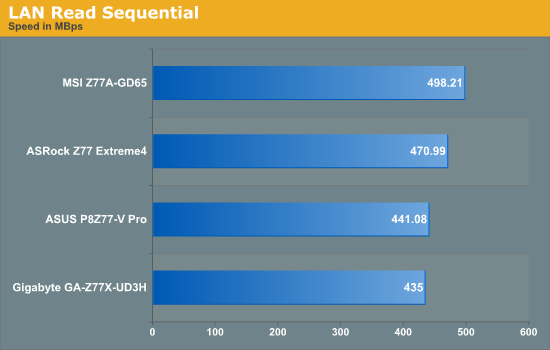
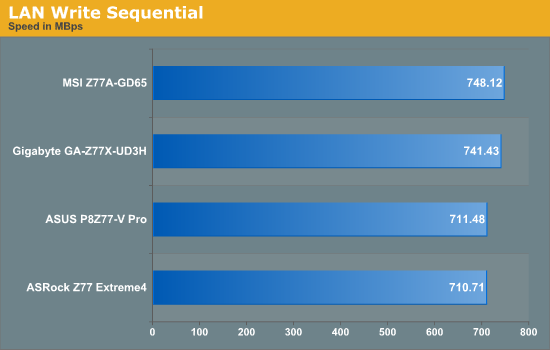
USB Speed
For this benchmark, we run CrystalDiskMark to determine the ideal sequential read and write speeds for the USB port using our 240 GB OCZ Vertex3 SSD with a SATA 6 Gbps to USB 3.0 converter. Then we transfer a set size of files from the SSD to the USB drive using DiskBench, which monitors the time taken to transfer. The files transferred are a 1.52 GB set of 2867 files across 320 folders – 95% of these files are small typical website files, and the rest (90% of the size) are the videos used in the Sorenson Squeeze test.
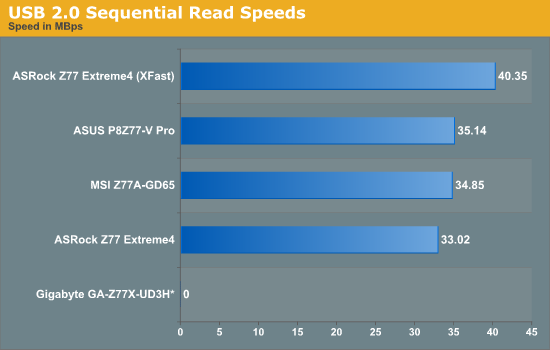
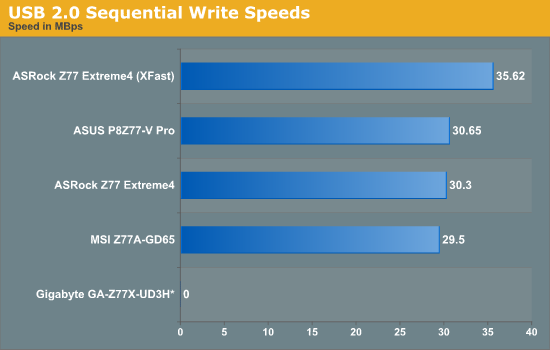
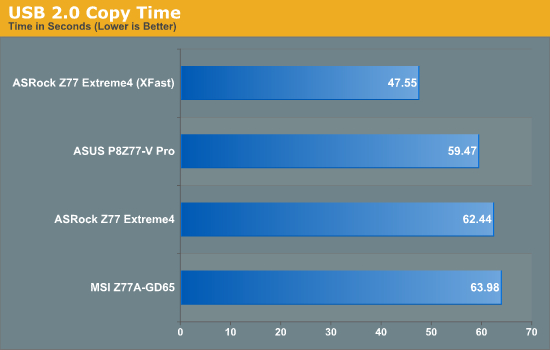
Due to the lack of Gigabyte USB 2.0 back panel ports, no results for the Gigabyte board were able to be fairly taken. In comparison, the XFast result from ASRock seems to speed ahead of the others.
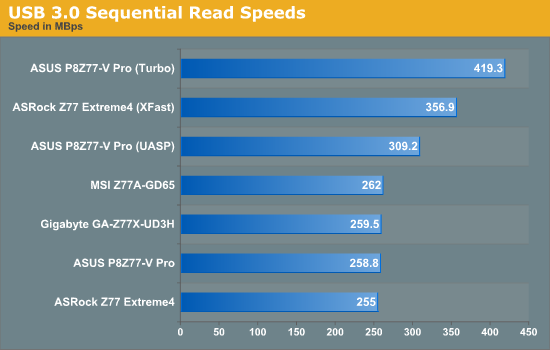
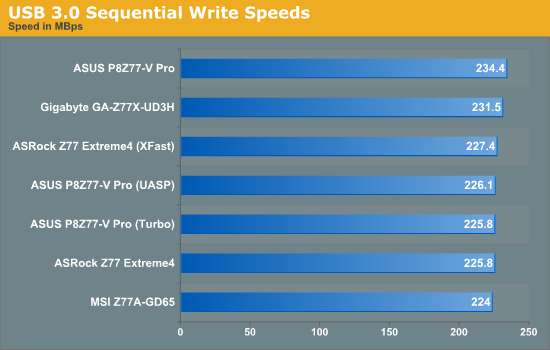
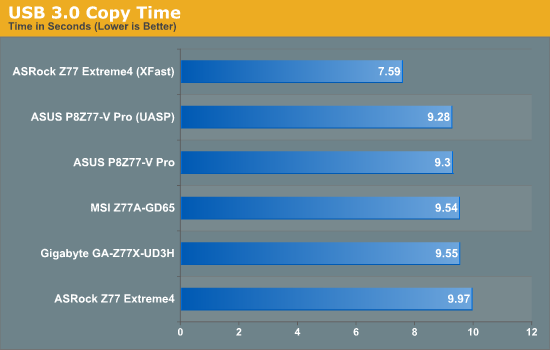
As this test deals with incompressible data at a Queue Depth of 1, UASP makes a difference in read but not in write. The adaptations performed by XFast are clear to see at this level.
SATA Testing
We also use CrystalDiskMark for SATA port testing on a C300 drive. The sequential test (incompressible data) is run at the 5 x 1000 MB level. This test probes the efficiency of the data delivery system between the chipset and the drive, or in the case of additional SATA ports provided by a third party controller, the efficiency between the controller, the chipset and the drive.
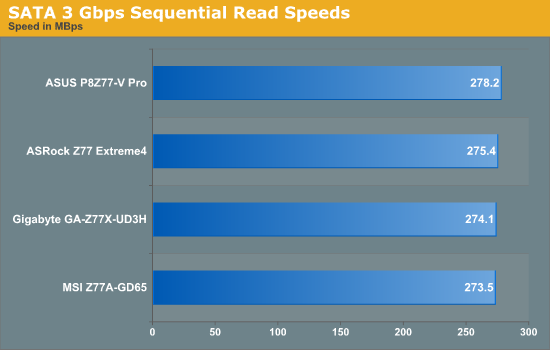
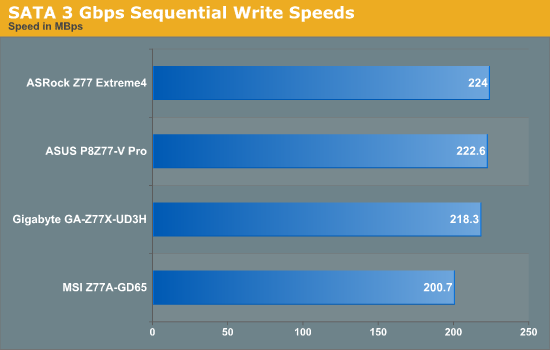

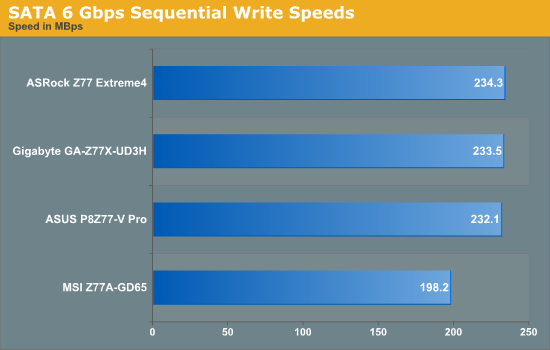
The MSI board seems to come out last in all our SATA testing.
DPC Latency
Deferred Procedure Call latency is a way in which Windows handles interrupt servicing. In order to wait for a processor to acknowledge the request, the system will queue all interrupt requests by priority. Critical interrupts will be handled as soon as possible, whereas lesser priority requests, such as audio, will be further down the line. Therefore, if the audio device requires data, it will have to wait until the request is processed before the buffer is filled. If the device drivers of higher priority components in a system are poorly implemented, this can cause delays in request scheduling and process time, resulting in an empty audio buffer – this leads to characteristic audible pauses, pops and clicks. Having a bigger buffer and correctly implemented system drivers obviously helps in this regard. The DPC latency checker measures how much time is processing DPCs from driver invocation – the lower the value will result in better audio transfer at smaller buffer sizes. Results are measured in microseconds and taken as the peak latency while cycling through a series of short HD videos - less than 500 microseconds usually gets the green light, but the lower the better.
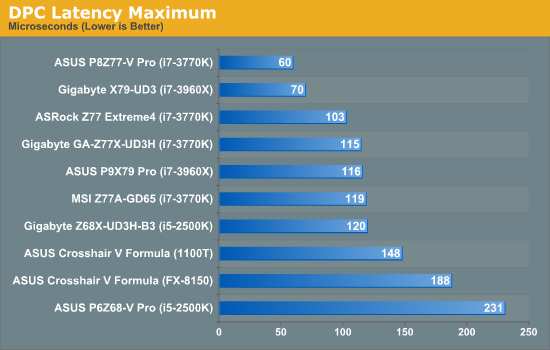
All the motherboards using Ivy Bridge chips do particularly well in our DPC test (as you would expect), with all boards coming in at under a very respectable 120 microseconds. The ASUS goes one step further with our lowest DPC score ever at 60 microseconds.










117 Comments
View All Comments
DarkRogue - Tuesday, May 8, 2012 - link
First off, thank you for the review.I am a bit bummed that the UD5H and the Z77 Deluxe were not reviewed, since those were the two I was looking at. Especially since the UD5H can be had for under $200.
Anyway, the voltage ripple/stability charts were quite interesting for me.
But my main concern lies with the Gigabyte's chart. It looks good... but in my eyes, TOO good. It's too perfectly straight. On one hand, I thought, "Wow, this board has awesome VRM or something."
On the other hand, it made me suspicious about why it was so stable. I have to ask, is it measuring the correct voltage?
The reason is because I had a similar finding when I was looking at the vcore requried to OC an IVB CPU (or any CPU, really) on the new Z77 mobos.
Per my thread here: http://forums.anandtech.com/showthread.php?t=22417...
We found that Gigabyte mobos were incorrectly reporting its VTT voltage as the vCore, which resulted in "vcore" readings in CPU-Z and other programs reporting the same, or very similar, 1.0xx voltages regardless of what the CPU OC'd to.
I hope to be able to get some clarification on this.
Only other suggestion I have is to really test more of the features of each motherboard. (mSATA, firewire, audio, etc; how do they compare with other chipsets, how are their drivers, etc..)
Thank you, and keep up the good work!
IanCutress - Tuesday, May 8, 2012 - link
Hi DarkRogue,I have the Deluxe on my test bed right now, so keep your eyes peeled for when I finish the review.
Regarding the voltage reading charts, it merely reads the OS reported voltage. This is loosely a smoothing of what ripple actually happens on board. After consideration, it only serves to show LLC on board, and how the board reacts to requested load by the processor. It's fairly easy for a manufacturer to override this to make sure only a straight line is reported. But, if it is a messy line, then there could be a problem (e.g. check my 990FX review a little while ago).
I'd love the kit to test more features on the boards (mSATA etc), if you've got any kit spare! :) Though keep in mind that each test can't take 2 hrs, or we would end up with 1 board a month reviewed (as we do this part time)! I'm open to suggestions regarding tests if anyone has a good one with a simple output I can report and analyse.
Ian
DarkRogue - Tuesday, May 8, 2012 - link
Thank you for your response, Ian!I wish I had the funds to send in spare items, though. Unfortunately, I'm not quite rich enough, haha. We'll have to be bound by the generosity of the various vendors to this site.
As far as tests go, I imagine some people would be interested in a quick RMAA test of the various audio chipsets. It's of no concern to me, since I insist onboard solutions are never going to be as good as a dedicated external DAC+amp, but it should be good for a lot of people.
I'd also be interested in how the eSATA and Firewire performs, as I'm of the camp that says anything firewire related that isn't Texas Instruments is not worthwhile. The eSATA, mainly it's to see if there are any quirks with the drivers from each manufacturer allowing hotswap properly or not, and whether it causes DPC latency issues. My friend's ASUS board was plagued with problems related to eSATA not allowing him to eject drives, BSOD'ing on resuming from sleep, causing massive DPC latency when a drive was connected, etc. It's these little things that really make or break the experience of a board.
I'd also like to see how well the fan controls are on each motherboard. ASUS' Fan Xpert 2 really drew me in, as it seems no one else can match the level of customization for fans. I dug a bit and found out that Gigabyte's boards not only cannot do this, but it even struggles to stay consistent between its various headers. (One header runs straight +12v no matter what, while the others make the fans spin at different speeds with the same settings.)
ANYWAY, back to the issue at hand - Gigabyte's voltage readings.
As I found in my thread linked above, Gigabyte appears to be reporting the wrong voltage, for some unknown reason. This to me seems to invalidate the test result for the Gigabyte board, because it's incomparable to the others.
I know that the purpose of the test is to test for variation in the voltage to the CPU, not necessarily the exact ripples, but the VTT supplies voltage to a completely different segment than the vcore, unless I'm mistaken. I wouldn't think that the voltage supplied toward the IMC would vary as much when the CPU ramps up and down.
Is there a way to force that program to probe a specific/different voltage reading, or have you already done this and the chart actually does represent Gigabyte's handling of vcore voltage? I wasn't able to figure that out from the article.
Thank you again!
UltraWide - Tuesday, May 8, 2012 - link
Thank you so much for covering the fan control features on each board! I truly appreciate this as it is often left out in other reviews.Keep up the great work!
AeroRob - Tuesday, May 8, 2012 - link
I don't know about anyone else, but I'm really sick of seeing VGA and PS/2 ports wasting space on new motherboads.I know some gamers might think that PS/2 does the job better than USB, and I can appreciate that, but VGA? Who even uses VGA connections anymore? They should be avoided like the plague.
And even if you do insist on using a VGA connection, what's the point of putting a DVI-D connector and a VGA together? Chances are you won't be using both, so just make it a DVI-I connector and throw in one of the cheap DVI>VGA adapters, and use the newly freed up space for a connector that isn't an ancient piece of garbage. Let's see HDMI or DP up there. Move things around so you can perhaps throw an eSATA connector on the back, or more USB ports--you can never have too many USB ports!
Paapaa125 - Wednesday, May 9, 2012 - link
PS/2 has one single thing that makes it superior to USB: you can turn your computer on by clicking space bar on a PS/2 keyboard or clicking mouse button on a PS/2 mouse. USB does not have this feature which is a big problem if your computer case is not easily reachable.Agree about VGA ports. Nobody uses them anymore. Nobody.
AeroRob - Wednesday, May 9, 2012 - link
As I understand it, gamers feel there's an issue with USB's polling rate, and prefer PS/2 for that reason.As for turning on your computer, I never heard about that. I rarely shut my computer completely off, and my wireless USB keyboard can wake it up from sleep just fine. Hell, my computer's so sensitive to any change, just flipping my monitor back on wakes it up (probably due to the built-in USB hub).
mcquade181 - Thursday, May 10, 2012 - link
I know whole organizations that still use VGA, and there are tons of KVM switch boxes in development and testing centres everywhere that only support VGA. Yes I know you can get HDMI and DVI KVM's but most places won't have them yet.I still use VGA occasionally and would be annoyed if it wasn't there.
Paapaa125 - Friday, May 11, 2012 - link
And how many of those organizations are switching to Z77 boards and still keeping their VGA?Ramon Zarat - Tuesday, May 8, 2012 - link
The latest AXTU version does not include XFastRAM anymore. XFastRAM is a stand alone utility now. Also, XFastRAM is much more than a 32bit 4GB RAM limitation extender. It's in fact a RAM disk on steroid, valid for both 32 and 64bit system. It can do the following:1- "Recycle" unused memory beyond 4GB on a 32bit OS into a RAM disk. A RAM disk of up to 32GB can be created on a 32bit OS.
2- RAM disk of up to 8GB on a 64bit OS. Asrock is working on extending that limit on 64bit OS.
3- Can choose any available driver letter to assign to your RAM disk
4- Use part of the RAM disk as a Readyboost drive to accelerate your magnetic boot drive!
5- Easy transfer of either or both the "user" and "system" temp file to RAM disk. No fooling around with Windows configuration.
6- Easy transfer of IE and Firefox cache to RAM disk. XFastRAM take care of everything straight from its interface.
7- Easy transfer of the page file to RAM disk. Again, directly from XFastRAM interface.
8- Possibility to save the RAM disk to hard drive before shutting the PC down.
It's fast (10 000MB/s with CrystalDiskMark on a 2500K @ 4.7 and 8GB of 1866 RAM) , it's free, it's amazingly flexible and can both accelerate your PC and prevent premature wear on your SSD by redirecting a lots of small writes to the temp folders and web cache! You can apparently gain 5X performance in some Photoshop operations when you configure it so use the RAM disk as the temp folder!